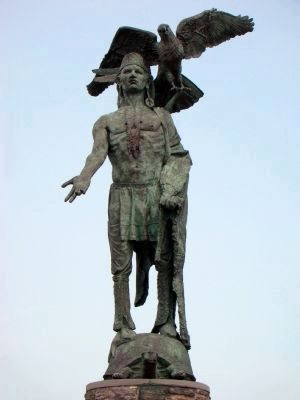In honor of the contributions of Native American Indians—the ancestors, the elders, this generation, and the generations to come—this sculpture commemorates Tamanend, a Sakima, of the Lenni-Lenape nation who resided in the Delaware Valley when Philadelphia, or “Coaquannock” was established.
Tamanend stands on a turtle, which represents Mother Earth. The eagle, a revered messenger of the Great Spirit has a wampum belt in its grasp. This belt recognizes the friendship treaty under the Shackamaxon Elm between William Penn (“Mikwon”), Tamanend (“the Affable One”) and other leaders of the Lenni-Lenape nation. It reads—“to live in peace as long as the waters run in the rivers and creeks and as long as the stars and moon endure.”
…many folk legends surrounded Tamanend and his fame assumed mythical proportions among the people of Philadelphia, who began to call him "King Tammany," "Saint Tammany," and the "Patron Saint of America." The people of Philadelphia also organized a Tammany society and an annual Tammany festival. These traditions soon spread across America. The reason for Tammany's popular status can be attributed to the need that patriotic colonists had to express a distinct "American" identity, in place of their former European nationalities. Tammany, an American Indian, provided an apt symbol for patriotic Americans to identify with.
Because of Philadelphia's political significance during the founding of the United States of America, Tammany soon became a national symbol throughout much of the newly formed country. (Tammany Hall)
.




No comments:
Post a Comment